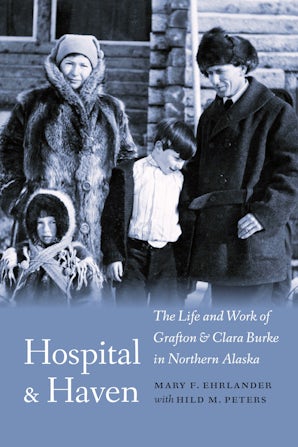"This is a book that will appeal not only to scholars of Alaska and the American West but also to those who seek a greater understanding of the role Christian missionaries played in late nineteenth- and early twentieth-century America. It is a strikingly balanced consideration of missionary work and successfully elevates Hap and Clara Burke to a central location in the history of Alaska’s territorial days."—Ian C. Hartman, H-Sci-Med-Tech
“With an abundance of letters, diaries, and photographs at their disposal, the authors of this important book present the reader with an almost day-by-day account of life in Fort Yukon in the early 1900s. The detail is rich beyond measure, and the voices of the Native residents of the Yukon Flats sing throughout.”—Ross Coen, editor of Alaska History
“The authors have researched and assembled an accurate and compelling narrative of the time in Alaskan history when the cultural and health-related consequences of Alaska Natives’ contact with Western culture were most significant and severe. In their dedication to meeting the challenges of managing a hospital in remote Alaska and providing compassionate and culturally sensitive medical care to the Native peoples of the Upper Yukon Valley, Grafton and Clara Burke set a high standard for those of us who followed.”—Peter Marshall, MD, chief medical officer of Indian Health Service Interior Alaska Service Unit, 1980–85; physician preceptor of the Fort Yukon Clinic, 1980–85
“Mary Ehrlander and Hild Peters masterfully tell the story of the service and sacrifice of a powerhouse medical missionary couple in the early 1900s. The Burkes served our Indigenous people of the interior, providing medical care, a home for orphans, and spiritual guidance under the constant stress of inadequate funding and epidemics, floods, famines, fire, a pandemic, and emergencies one after the other. They never gave up.”—Darlene Taylor Bishop, retired teacher, Koyukon Dena’ (Rampart), Alaska
“The Burkes’ life serving the Episcopal church in Alaska is witness to a mission of genuine love for the life, health, spirit, and beauty of Native Alaskans. Hospital and Haven is a story of love’s power to bind people together, not just as individuals but as a community. As important, it is a story of love’s power to seek justice and respect for the dignity of all God’s children—the church’s baptismal vocation to stand firm against the powers of racism, bigotry, and exploitation. Mary Ehrlander and Hild Peters have told this story beautifully and richly. Grafton and Clara Burke came to serve and love God’s people whose home was and is this land. Their example has been imprinted on this diocese. It should likewise be imprinted on the whole church.”—Mark Lattime, bishop of the Episcopal Diocese of Alaska
“Hospital and Haven describes well the life of a physician and teacher who gave their all to provide care to a community they loved. The scope of medicine involves trauma, malnutrition, infectious disease, emotional illness, poverty, substance abuse, and chronic disease. Situations described in the book ring familiar to medical issues we currently address in the world: tuberculosis, access to care, affordable care, quality care, scope of practice, staffing, leadership, and burnout.”—Jean Tsigonis, MD, MPH
“Hospital and Haven is the story of the hardships Clara May Heintz Burke and medical missionary Dr. Grafton (Hap) Burke faced, the amazing work they did saving lives, raising orphans, and trying to ensure that the rules of law were upheld. The impact of their work is measured in lives saved and lives nurtured to maturity, a legacy reflected in those who still recall their gratitude to the Burkes.”—William Schneider, professor emeritus of library science, Elmer E. Rasmuson Library at the University of Alaska Fairbanks
“Grafton and Clara Burke are treasures in Alaska history. Their dedication and perseverance to meet critical needs of Alaska’s Indigenous population were nothing short of heroic. Mary Ehrlander and Hild Peters provide an entertaining glimpse into the Burkes’ thirty years of service while also introducing us to colorful characters waging their own battles to survive the challenges of the rugged Arctic environment.”—Bill Gordon, a lifelong Alaskan who has served at the highest levels in business and government and son of Alaska’s Flying Bishop, William Gordon
“The Burkes made such a lasting impression on my home community of Fort Yukon and, three generations later, on my own life. Hospital and Haven is an enjoyable reading of their familiar story and their impact.”—Grete Bergman, Fairbanks and Fort Yukon, great-granddaughter of the Rev. William Loola
“Ehrlander and Peter’s book is a well-researched and refreshing read as we live amid discord based on politics, economics, religion, ethnicity, and social beliefs. Dr. Grafton and Clara Burke chose to live with the Gwich’in people in Alaska for over twenty-five years in the early 1900s. The people stole the couple’s hearts. Hap and Clara desired to teach the English language, medicine, and ‘American’ and Christian beliefs. This became a two-way street. The Burkes were inspired by and learned from the Native people they respected and loved.”—Nancy Cook Hanson, retired director of Catholic Schools of Fairbanks
